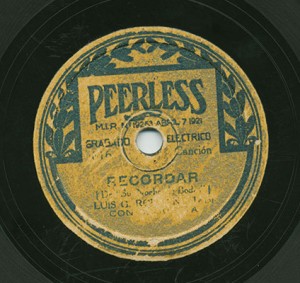Discos Peerless Discography
To view the Peerless Discography click here.
Discos Peerless, S.A.: A Label Discography
Introduction by Chris Strachwitz
Discos Peerless S.A. was Mexico’s first major record producing and manufacturing firm. The Peerless label, probably under the ownership of Gustavo Klinkwort, first appeared around 1929 with a 7000 series, which included several releases by singer, composer, and pianist, Agustín Lara, who would soon become one of the major stars of Mexican popular music. Around 1931 or ’32, the label began an 800 series which soon introduced a new matrix series (probably starting with matrix #1N by release number 829). On Monday, August 14, 1933, the firm was incorporated when Mr. Klinkwort joined with Eduardo Baptista to form Peerless, S. A. It could well be that matrix #1N marked the beginning of this joint venture. The date of the incorporation is given in a special edition of “DiscoMexico” (Ano XII, #94, September 1983) devoted to the 50th anniversary of Peerless Records entitled “La Primera Compania Fonografica De Mexico: 1933-1983”. Eduardo Baptista brought considerable experience to the new corporation, as he had previously operated the Olympia (1926-27), Huici (1927-28), Artex (1927-28), and Nacional labels which had waxed Guty Cardenas and Tito Guizar among other rising stars.
By the time the Peerless corporation began, many of the early stars had already recorded for American Columbia and Victor. Both of these giant American firms, along with Edison, had begun recording in Mexico around 1904 and made several trips until 1909 when the revolution made such trips too dangerous. By 1926, Victor resumed field trips to Mexico and apparently had agencies in Mexico City and Veracruz that not only distributed records and phonographs made in the USA, but also searched for talent. Victor, however, did not feel secure enough to open its own production and manufacturing facilities in Mexico until around 1935. Columbia apparently never returned to Mexico to make recordings after 1908 since they discovered that there was plenty of talent north of the border. Columbia, however, also had established distribution in Mexico but did not build their own production facilities there until 1946!
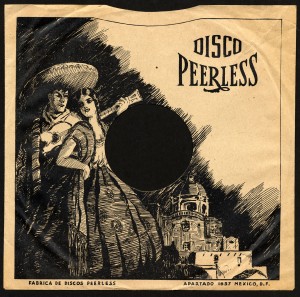
The first Peerless hit, according to Leo Porias (quoted in the above named publication) was in 1936 when Los Trovadores Tlalixcoyanos recorded “Camioncito Flecha Roja” (Red Arrow Busline -no doubt about the trials and tribulations of riding on a third class Mexican bus!) which allegedly sold 3000 copies. This was followed shortly by “El Barrilito” (The Beer Barrel Polka) recorded by the conjunto of the Dominguez Brothers, which sold 5000. Peerless finally hit real gold when, under the artistic direction of Don Guillermo Kornhauser, it recorded the soon-to-be #1 Mexican singing and movie idol, Pedro Infante, on November 5, 1943. Peerless has continuously released music of all types under that imprint to the present day, from semi-classical to regional – not only recordings of Mexican origin, but also licensed masters from other countries. Collectors of rock ‘n’ roll classics might be interested in Peerless 78 rpm pressings by the Rolling Stones, which were indeed available in Mexico in that format at that late date!
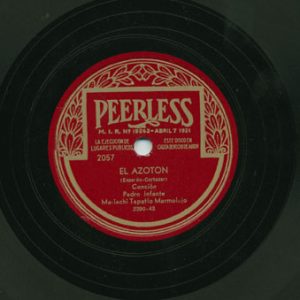
From past experience, I was aware of the fact that many record companies, especially in Mexico, are suspicious of anyone trying to obtain discographical information. They generally consider this confidential data because they feel it might reveal sales figures and/or royalty payments to publishers and/or artists, or the lack thereof. Fortunately, Jonny Clark, a mariachi researcher, brought a copy of one of Dick Spottswood’s monumental volumes of Ethnic Music on Records to show as an example of a discography: a catalog of all the artifacts or holdings (by matrix number) which a record company and/or the artists have produced, and therefore a valuable asset to all those firms who have ever found it financially or culturally rewarding to re-release older recordings.
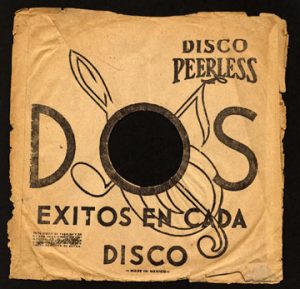
In the summer of 1995, under the direction of Prof. James Nicolopulos, Jonny Clark and I requested permission to document the early years of the Peerless label. The head of the royalty department, Natalia Gonzalez, whom Prof. Nicolopulos had met the previous year, invited us to consult the documents in her office, but we had not received a formal invitation from the head of the firm. We figured it was now or never and left for Mexico determined to document the label as much as possible. Fortunately, shortly after our arrival, we were able to meet with the then president of Peerless, Ing. Jurgen Ulrich, who was born in Mexico but educated in German schools and fluent in that language! Due to my sad lack of proficiency in Spanish, we had a fruitful conversation in German about the importance of documenting the holdings of a firm such as Peerless. When Mr. Ulrich saw the impressive work done by Richard K. Spottswood in documenting ethnic recordings made in the United States, we were welcomed to begin our task with his complete cooperation. Mr. Ulrich personally gave us a tour of the large plant and showed us all the documents and artifacts still in existence. He also showed us the archives where the tapes for most LP releases were stored, and a rather messy room filled with metal matrixes that did not seem to be sorted. Examining a few here and there, we soon determined that they did not include any pre-1939 items.
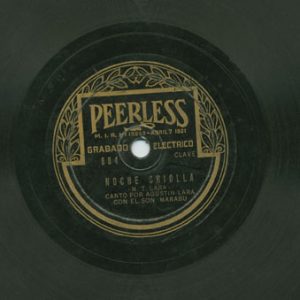
Back to our tour of the Peerless plant: A very small room, partitioned from a larger space, contained the most interesting artifacts from my standpoint – namely 78 and 45 rpm discs pressed by Peerless after 1939. The run of Peerless pressings seemed to be complete, in chronological order, neatly stored in albums holding about 10-12 discs each. All discs were in mint condition – file copies – one example of each. On one shelf I discovered samples of pressings made by Peerless but not necessarily issued by them. These albums of 10-12 discs each contained rare custom pressings, including some of corridos which on occasion had a picture on the label of the politician in whose honor the song was composed. Some albums contained samples of other labels manufactured by Peerless, including a few later ORFEO items and some on the TEXAS label. Although we began to obtain our data mostly from the 78 rpm record labels themselves, taking the matrix numbers from the lead-out grooves, this soon proved very time-consuming. Fortunately, Peerless prints their matrix numbers as well as the catalog number on the record labels. When we got back to the office, Ms. Gonzalez discovered to our delight that books of label copy existed, and so the bulk of the catalog information and data was eventually derived from the label copy for each disc. The new and very logical matrix formula initiated in 1939 assigns consecutive even numbers to all masters beginning with the number 2, followed by a dash and the last two digits of the year of the recording. Some masters were licensed from the United States or other sources, but it seems that no older or pre-1939 Peerless masters were re-issued since they had indeed been destroyed. I did however find one box with approximately 30 older Peerless items which someone had obviously saved because of the famous names of the artists. The matrix numbering system continued up to the end of the 78 rpm era, in the late 1950s. In a few instances, alternate takes were issued. Odd-numbered matrices represent these.
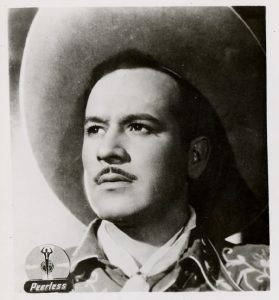
The other interesting artifact which survived is a set of original, handwritten log books. Book #1: 1945-1950 (matrix 3264-45 to 8592-50); Book #2: 1951-1954 (this book was missing); Book #3: 1955-1958 (matrixes 13602-55 to 17862-58). Since we were unfortunately unable to xerox these fascinating recording logs, Jonny Clark did begin transcribing some of the data from book #1, but it was a slow job and was abandoned when I mentioned that our prime effort was to complete the basic catalog. These log books contain exact recording dates, often names of accompanying musicians, matrix numbers, and alternate take (if any). They also show interesting hand-drawn diagrams about the location of mikes, and even cutter head readings and other technical data for each session. The volume which included the first recording session of Pedro Infante was missing, much to the concern of Mr. Ulrich and the man in charge of the archives. Unfortunately, without these log books no complete and accurate discography of Pedro Infante, or any of the other artists, can ever be completed. Jonny Clark, who stayed on the longest, supervised data entry through release number 2391 (recorded and released in 1943). The bulk of the entry work was done for us by Ms. Alicia Cornejo of the Peerless office, who did much of the entry work after hours and at home at a very reasonable rate. She seems to have been very accurate and careful in her work. Our deepest thanks go out to her.
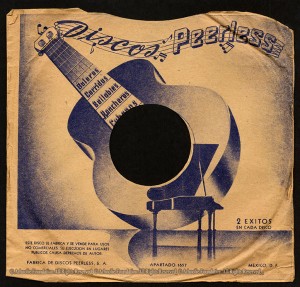
Notes:
This label discography begins with a number of 78 rpm pressings which show no catalog or release numbers. We found these single file copies in the Peerless archives and most of these appear to be custom pressings of limited circulation, probably not commercially distributed. Many of these, however, would appear to be of historical interest. In some cases, the label shows a picture of the political candidate about whom the corrido on the record had been composed. The matrix numbers indicate what we saw written in the wax of the lead-out grooves.
The last known release number from the old plant is Peerless #1369 from early 1939, and we can assume that no releases exist until the first release from the new plant (#1501) with new master numbers.
To view the Peerless Discography click here.
[feather_share]

